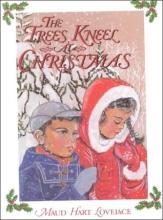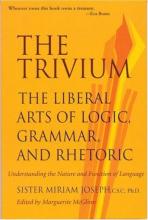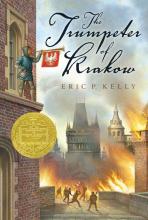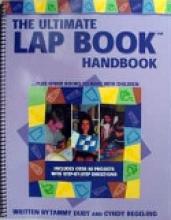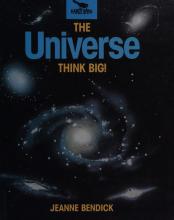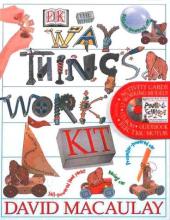No name
The Trees Kneel At Christmas
Maud Hart Lovelace is famous for her Betsy-Tacy series of chapter books. The Trees Kneel At Christmas is a delightful story of two Lebanese-American children in 1951 Brooklyn. Their grandmother tells them how the trees kneel on Christmas in their homeland of Lebanon, but in their new home of Brooklyn the people do not have enough faith for the trees to kneel.
However, the children do have faith and they set out to prove that the trees do in fact kneel down in honor of our Lord's birth in Brooklyn. When the adults leave for Midnight Mass, the children sneak away to the park so that they can witness the trees at midnight.
This is a story about having the faith of a child, the kind of faith that Jesus calls us all to hold.
The Trivium: the Liberal Arts of Logic, Grammar, and Rhetoric
This little gem was used as a freshman college course after the author met philosopher Mortimer Adler and understood the importance of teaching basic language skills as the foundation of other learning. After some years of study, she put together this course in the Trivium, the three language arts – of word relations (grammar), concept relations (logic), and composition (rhetoric). The result is a primer in Aristotle's Categories, a demanding course in logic, and a prerequisite to good composition. It is not, mind you, a course in grammar conceived as the study of commas, periods, and subjunctive verbs, though it might lead to insight into these matters. Not is it a course in "symbolic logic", the modern logic stripped of thought and studied simply as a form of mathematics. Rather, Sister Miriam offers a prerequisite to philosophy and writing, for this is a course in clear thought and the right use of language.
With all this, The Trivium is demanding, yet it is very accessible. Despite its original use as a freshman college course, it reminded me very strongly of my high school logic text, which, like this, was the work of an obscure nun who had studied Aristotle and wanted his clarity to form the minds entrusted to her care. I look forward to the opportunity to use it at the high school level.
Not only is the volume accessible, but one must delight in its literacy. The illustrations are taken from the great literature of western culture – so the mind is always lifted. It is a pleasure to read, and study is always rewarding, because every step sparkles with beauty and interest as well as clarity. Many of Sister Miriam's examples were originally taken from great literature; her loving editor Marguerite McGlinn has taken the liberty of replacing those illustrations which were time-bound with even more good literature so as to move the book into its rightful place as a timeless resource.
For those who know and love Dorothy Sayers' little essay on the trivium, it may be appropriate to warn that this is not in any sense a resource for primary or middle school children.
The Trumpeter of Krakow
The Trumpeter of Krakow is set in fifteenth century Poland. The main characters are Pan Andrew, a Ukranian farmer, his son Joseph, and Elzibieka, the niece of a neighboring alchemist. Joseph and his parents flee to Krakow after their home and fields are mysteriously burnt. Joseph thought that they had left all their troubles behind them, but a villain named Button Peter continues to pursue them, trying to get something of great value from them. When they reach Krakow, Joseph's father surreptitiously changes their names, leaving behind all traces of their past.
The story focuses on two Polish legends: the story of a young trumpeter in the church of Our Lady Mary, who keeps his oath as trumpeter, even to the death. The second is the Great Tarnov Crystal – reputed to be a thing of great beauty and power. Joseph Charnetski and his family are bound by an ancient oath to protect this famous jewel from any who would try to take it.
The Trumpeter of Krakow was first published in 1928. The book has several villains and many twists and turns in the plot. It is fast-paced and exciting. My brothers and I give it a nine out of ten rating. We all enjoyed the style of writing and found the plot adventurous. I would recommend this for grade six and up or a great family read aloud.
Reprinted many times.
The Ultimate Lap Book Handbook...Plus Other Books to Make with Children
When it comes to craft projects, I am all thumbs. If I must struggle with following incomprehensible directions and managing difficult techniques, I prefer to end up with something delicious to eat. You can imagine my fear when I was first introduced to lap books–-described by the author of the Ultimate Lap Book Handbook as "a file folder folded a funny way, and then filled with child-produced booklets". As I read through this book, my fear turned to fascination. This was one incredible project that even I could handle!
The authors begin with a very convincing ten-reason list of paragraphs describing why and how the making of books is beneficial to a student of any age. They continue with a section on Lap Books, including the basic ways of folding the folder and the booklets that go inside. Construction, assembly, and layout techniques are also discussed, and cover designs and FAQs are described. The next section is titled "Beyond Lap Books" and contains the instructions for making simple books, stick books, pizza books, hardcover books, and more. Are you getting overwhelmed yet? Don't! This is where most "how-to" books end, expecting you to be able to apply these ideas to your own homeschool. The Ultimate Lap Book Handbook is just getting to the best part.
The heart of the book is the Book Blueprints section. The authors proceed through Bible, History, Literature. Math (Yes! Even Math!), Science, and Social Studies, and they offer step-by-step directions for more than fifty projects at all grade levels. Will your 3rd-8th grade student be studying the Ten Commandments? Does your high schooler need a Math Formula Flip Book? Would your K-4th grader enjoy making a Weather book? The well-illustrated project directions provide no-fail projects for the craft-challenged as well as a comprehensive range of starter ideas for experienced "Fun Moms". Many black-and-white photographs of finished projects are also included. Each project description includes Writing Prep and Presentation sections in addition to any helpful tips. More advanced projects also include a list of materials, suggested booklets for the inside, assembly directions, and evaluation guidelines. These techniques can be used with any homeschooling method from strictly classical to unit study to textbooks. They can be used with just one child or a CCD class or a Scout group. I can't wait to get started making our next book!
The Universe in My Hands
The author, Mary Daly, explains her book and purposes in this overview.
I have long had a concern about the teaching of science. Most of the materials on the market are so scattered that I cannot think that children will have a clear concept of the meaning and value of science, nor any feeling that they can master its contents in any way. Indeed, most texts are centered on defining science as the product of a specific "method" of thought which has to do with hypotheses and experiments and records and reports. Boring ...and not at all the way Einstein or anybody else I know of actually operated.
Anyway, Natural Science was born in response to the command in Genesis: "Increase and multiply and fill the earth and subdue it." We cannot subdue – or exert stewardship – over what we do not understand. Science is about understanding the material world, our very exciting and beautiful home. In the spring of 2000, members of the local homeschool support group met for a week's science camp, and the next two years, followed up with weekly (almost weekly) science lessons.
The principle of organization is to understand the magnitudes – the sizes – of things and how their scale limits what they can be and do. A star, for example, cannot be much smaller than our sun – except by being fantastically dense – because the nature of stars requires that their gravity bring about their burning. A fly doesn't have enough gravity to burn that way. The planet Jupiter has almost enough.
With the curriculum organized around magnitudes, we had a principle of order for the relationships between all the disciplines of natural science, and as our body of knowledge increased, it was always interactive with previous information. Furthermore, there are only 45 magnitudes between the quark and the universe; this is a small enough number for any child to comprehend. He can finish the course feeling that he knows the universe – and why not? It is his home.
The science camp material is now available, suitable for a camp, or a semester, or up to a year for a small child. It includes:
1. A booklet about the 45 orders of magnitude – sorted by powers of ten – which form the universe as far as we know it. The booklet goes very slowly through the nine orders readily recognizable to ordinary sight – from a meter down to a tenth of a millimeter, and then up to ten kilometers. (It is really essential to use metric measure for this exercise. It is not assumed that the student already knows it.)
2. A set of 45 cardstock dividers, numbered and color-coded, one for each order of magnitude. These are to be placed in a notebook and materials collected illustrating objects at each magnitude are to be placed in each section by the student. These materials can be pasted pictures, drawings, reports, web printouts – whatever best represents what the student has considered at that order of magnitude, and according to his level of comprehension.
The color-coding of the dividers has to do with the fact that the smallest things we consider – electrons and protons, are studied in physics. The next smallest – molecules – are the study of chemistry. Then biology, with green dividers, and so forth.
I will be working to get the following year's lessons into print. They strengthen the magnitudes theme by taking various objects and explaining their characteristics, always in relationship to the orders of magnitude that shape them. Of course the lessons were printed at the time for my students, but not always in a well-finished form...
Copyrights 2002/2006
Consists of a booklet and a set of 45 cardstock dividers for a 3 ring binder.
The Universe: Think Big!
Jeanne Bendick, author of Archimedes and the Door of Science, explains some basic concepts regarding the universe in a surprisingly simple way (approximately 2nd grade reading level - short pages with large type). First she invites children to try to imagine how big the universe is (in terms of it being much, much bigger than other, more familiar things). The bulk of the book focuses on large distances and how they're measured and how people used to believe that the earth was at the center of the universe and remained motionless. The final page explains the big bang theory. For a controversial topic it is explained rather nice in terms of "How did the Universe begin? Nobody knows for sure, but here is what most scientists of today think." Although the big bang theory was first thought of by a Catholic priest (LeMaitre) who was trying to point toward something which God created, we all know that the big bang theory is often used to try to explain God away. Young children don't have much trouble with this when presented as it is in this book. After the book says "Suddenly, this object exploded with a big bang," you can ask your children, "If this is the way the Universe really did begin, then who made the explosion happen?" Chances are, they'll know the answer. :)
The Victory Garden Alphabet Book
I found this in our library's seasonal display... copyright 1992, certainly not a new title, but my love for alphabet books and vegetables together made me decide to take a look.
Product description: Bestselling author Jerry Pallotta teams up with former Victory Garden host Bob Thomson to present 26 common and not-so-common vegetables. Learn about fiddleheads, munchkin pumpkins, sweet peas, walla wallas, and more. This informative book also includes a brief introduction to soil preparation and seed planting. 30 color illustrations.
These times of economic slump and contaminated foods from doubtful origins is seeing a huge growth in home gardening. I have seen this new trend being referred to as "Victory Gardens" all over again. This is a nice and informative book for children, most especially children whose parents want to encourage to get out there and help! The illustrations are very realistic and seem to be based on photos.
The Virtue Driven Life
The Way Things Work Kit
This kit provides dozens of special cardboard pieces, wooden dowels string, wheels, etc. for making simple machines (inclined planes, scales, etc.) that can be used for understanding basic concepts of mechanics – how things work. Based upon the bestselling "The Way Things Work" by David Macaulay, the kit continues the theme of Wooly Mammoths as props and characters for use in these experiments. (Included in the kit are two cardboard Wooly Mammoths to which you affix a certain number of identical coins to provide a common weight for some of the experiments.) A thin, but colorful book (32 pages – glossy cover) takes you through the scientific explanations of the various principles involved in the experiments. 5 1/2 " x 8 1/2" glossy full color cards provide detailed step-by-step instructions (with the typical DK photos) for each experiment.
Although some of the experiments took a little more finesse than might have been expected (but understandable due to the limitations of the materials) and some of the instruction cards were a little hard to follow, overall we found this to be an exceptional value – a lot of bang for your buck at the $30 retail price. We found that a dozen or so ziploc bags were very helpful in keeping the various pieces straight and, with a little patience, all the pieces can be stored in the box.
The biggest hit in our family so far was the Pinball Science CD ROM which also came with the kit.  The game includes three pinball arenas each having a specific theme (village, island and moon). The science part involves answering questions in order to earn the right to place certain fixtures on each pinball game. Without the fixtures, scores are lower and players are unable to advance to the next level. With each question, the player has the option to "Research Answer". This feature takes the player to the appropriate page in an interesting, humorous and interactive log book which explains the functioning of various devices such as windmills, faucets, hot-air balloons, gears, and rockets. Some of the graphics are a little silly (Wooly Mammoths in bikinis on the island and such), but I didn't find anything really objectionable.
The game includes three pinball arenas each having a specific theme (village, island and moon). The science part involves answering questions in order to earn the right to place certain fixtures on each pinball game. Without the fixtures, scores are lower and players are unable to advance to the next level. With each question, the player has the option to "Research Answer". This feature takes the player to the appropriate page in an interesting, humorous and interactive log book which explains the functioning of various devices such as windmills, faucets, hot-air balloons, gears, and rockets. Some of the graphics are a little silly (Wooly Mammoths in bikinis on the island and such), but I didn't find anything really objectionable.

